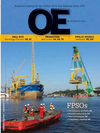
Page 12: of Offshore Engineer Magazine (Sep/Oct 2014)
Read this page in Pdf, Flash or Html5 edition of Sep/Oct 2014 Offshore Engineer Magazine
Opinion
Thought Thought ThoughtStream
Michelle Smidt and Dr. Karen Becker, Queensland University of Technology
Workforce-related risks in oil and gas projects: identi? cation and analysis s investment in oil and gas projects such as duration of project, remuneration way the low, medium and high workforce-
A is set to continue globally, it becomes and bene? ts, location, employer brand of related risk areas. It also identi? es those increasingly relevant for the organizations operating company, roster, and the phase areas where there is a high level of uncer- managing such large scale developments of the project. tainty within the management team about • Recruitment: to take measures to limit and prevent This depends on factors the critical workforce-related risks. schedule and budget overruns. There are such as clarity of needs, necessary pro-
This tool, entitled PREP™ (people risk concerns that not being able to get the cesses and procedures, whether skills are evaluation of projects), is currently under development, but it is the intention that right people at the right time for the right available to meet demand, quality of local it will greatly improve how projects are cost could inevitably threaten the overall talent, reference checks, expectations, and project delivery. internal client policies and requirements.
managed and mitigate risks, by not only
Risk assessments and registers are by Key issues broadening the view of organizations • Induction & Onboarding: no means new to the industry, or to the here are use of a formal induction pro- to consider not only workforce-related people running these projects, however, cess, organizational cultural alignment, issues and technical risks, but encourage to date, such assessments have taken time requirement, upskilling and train- them to adapt their current approach to a very technical approach and also a ing, as well as industry experience. risk assessment in order to better get to • Retention: limited view of what “risk” encompasses. Several key issues with the heart of workforce issues. By doing
In fact, many project managers will tell retention deal with loyalty, management this we believe that many of the current you that at the core of any project delay or support and style, career development schedule and cost overruns experienced project overspending is a personnel issue. opportunities, poaching, alignment with by many of today’s oil and gas projects
It is these workforce-related risks that company culture, equity, staff versus con- can be signi? cantly reduced. our research at Queensland University of tractor bene? ts, personal circumstances
Technology (QUT), in collaboration with and taxation.
• Demobilization: This stage presents Michelle Smidt serves as a research proj-
Air Energi, intended to document in more the highest risk in terms of resources ect of? cer at QUT. She recently worked detail. By doing so, we hoped that more and time invested. Key issues are project on a research project jointly funded by organizations would consider such risks as completion, continuity, client/labor hire the Australian government and Air Energi part of their current assessment process.
Although many of our ? ndings may agency relationship, identifying skills investigating people-related risks on LNG be unsurprising to those with extensive and capabilities for future use, succes- projects involving a contract workforce. industry experience, they do con? rm sion planning, reputation control, con? - Michelle was responsible for gathering the importance and continued impact of dentiality and sabotage. and analyzing the data which enabled the • Compliance: these risks, and break them down in a Such factors include development of the PREP™ tool. Michelle way that hasn’t been done before. complying with the legal requirements of completed a Bachelor’s in English and
In brief, through in-depth interviews the location and country but also internal employee communications in 2011 from with industry experts, our research organizational policies. Copenhagen University and a Master’s of documented six key areas of people- However, identifying these risks is just Business HRM at QUT in 2012. related risk: project appeal, recruitment, the ? rst step. A critical outcome from the onboarding and induction, retention, research is the ability for those managing Karen Becker is an associate professor, demobilization, and compliance. Each a project to be able to identify the speci? c researcher and lecturer at QUT Business of these was further explored to reveal issues that present the biggest risks, and School. Karen is an active researcher in a subset of risks (To read the full ? nd- proactively take steps to mitigate them the area of strategic HRM, learning and ings of the report titled, “Workforce- wherever possible. development, innovation and change in related project risks,” visit the Air Energi From the ? ndings, we developed a the workplace, and prior to joining aca- website: http://www.airenergi.com/sites/ survey to identify which of the six key demia spent 12 years in corporate HRM default/? les/brochures/prep.pdf). risk areas are likely to apply to a speci? c and HRD roles, and as an HR consultant. • Project appeal: The attraction of can- project. The results of the survey combine Karen has published over 40 peer- didates will depend on the attractiveness to produce a results report and an interac- reviewed journal articles and conference of the project itself. This includes factors tive map that illustrates in a very simple papers relating to her research.
September 2014 | OE oedigital.com 14 014_OE0914_thoughtstream.indd 14 8/21/14 2:16 PM

 11
11

 13
13